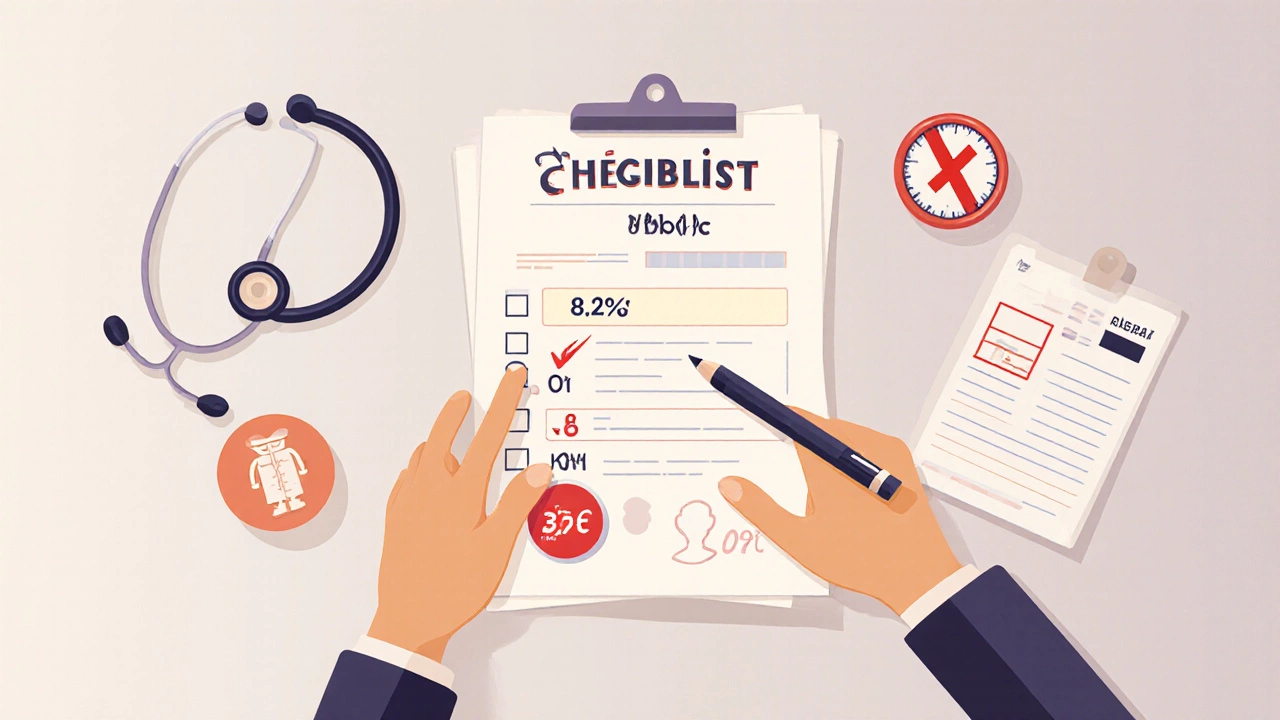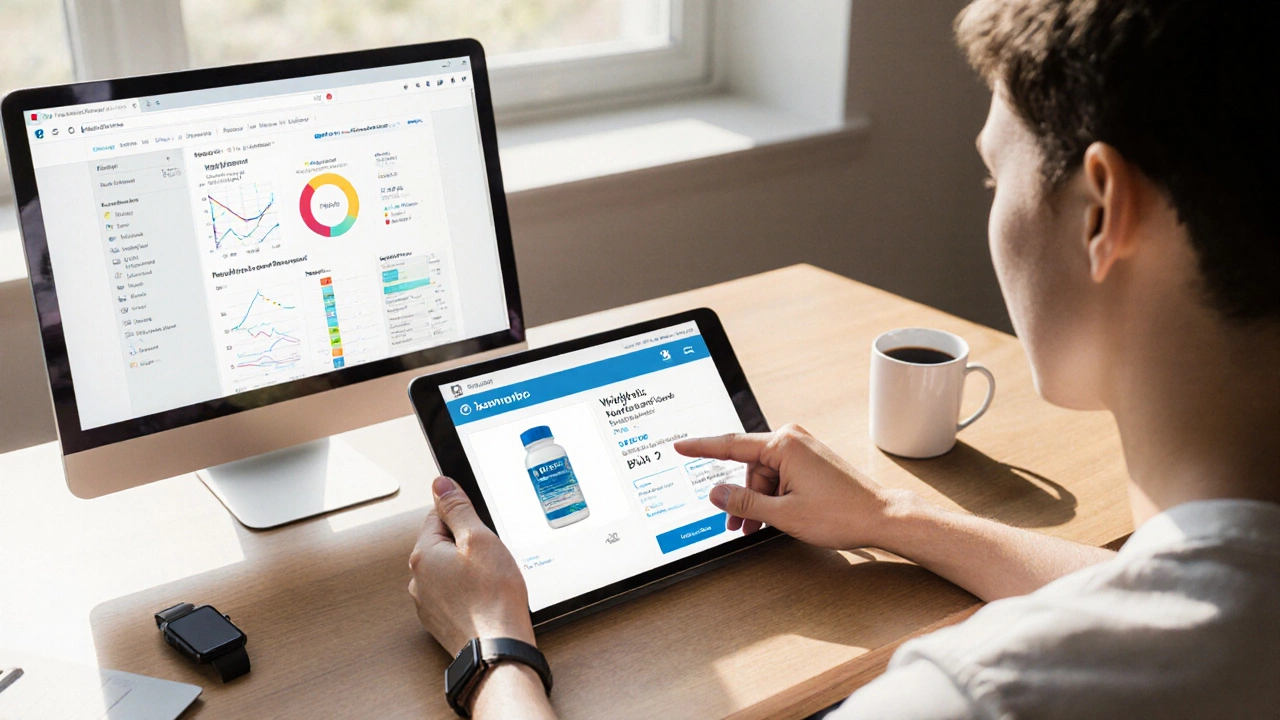Ozempic Eligibility Calculator
Check Your Eligibility
This tool helps determine if your BMI meets the basic criteria for Ozempic eligibility based on FDA guidelines.
Enter your weight and height to see if you meet Ozempic eligibility criteria.
What you need to know
For Ozempic eligibility:
- For weight management: BMI ≥ 27 kg/m² with at least one weight-related condition
- For diabetes management: Any BMI with type 2 diabetes diagnosis
- Must have HbA1c between 7% and 10% for diabetes treatment
- No history of medullary thyroid carcinoma or MEN 2
Important Contraindications
Before starting Ozempic, discuss with your doctor if you have:
- Thyroid cancer or family history of medullary thyroid carcinoma
- Personal or family history of multiple endocrine neoplasia type 2 (MEN 2)
- History of pancreatitis
- Severe gastrointestinal issues
When you’re scrolling through an online pharmacy and see Ozempic listed under weight‑loss or diabetes control, the first question that pops up is: "What do I need to say to get approved?" You’re not alone-many people wonder which exact words convince a prescriber that they meet the medical criteria.
Ozempic is the brand name for semaglutide, a GLP‑1 receptor agonist approved to improve blood‑sugar control in adults with type 2 diabetes and, more recently, for chronic weight management. Below you’ll find a step‑by‑step guide that covers the medical facts, the phrasing doctors expect, and the paperwork online pharmacies typically ask for.
Understanding the Core Requirements
Before you can even think about the right script, know the baseline criteria set by the FDA and most health insurers. These are the same standards that telehealth platforms and traditional clinics use.
- Diagnosed type 2 diabetes (or pre‑diabetes with a BMI threshold for weight‑loss indication).
- Age 18 years or older.
- Body mass index (BMI) ≥ 27 kg/m² for the weight‑loss indication, or any BMI if you already have type 2 diabetes.
- HbA1c (glycated hemoglobin) level typically between 7 % and 10 % for diabetes treatment, though some clinicians accept a broader range.
- No personal or family history of medullary thyroid carcinoma (MTC) or multiple endocrine neoplasia type 2 (MEN 2), as these are contraindications.
These data points are the backbone of any qualifying conversation. If you can present them clearly, the prescriber’s job becomes much easier.
Preparing Your Personal Health Snapshot
Gather the following pieces of information before you schedule a tele‑consultation or fill out an online questionnaire. Having them ready saves time and improves your chances of a smooth approval.
- Latest lab results: Look for your most recent HbA1c value and fasting glucose numbers.
- Current weight and height to calculate BMI.
- List of all medications you’re taking, especially other diabetes drugs, GLP‑1 agonists, or insulin.
- Brief medical history highlighting any thyroid issues, pancreatitis, or kidney disease.
- Insurance details if you plan to use coverage for the prescription.
When you upload these documents to an online pharmacy portal, the system often auto‑fills parts of the prescriber’s intake form, making the qualification step faster.
What to Say During Your Telehealth Visit
The exact wording matters because clinicians look for specific trigger phrases that align with the eligibility criteria. Below is a concise script you can adapt to your own situation.
“Hello Doctor, I have been diagnosed with type 2 diabetes for X years. My most recent lab work shows an HbA1c of Y % and my BMI is Z. I’ve been on metformin + GLP‑1 (or other regimen) for N months, but my blood‑sugar levels are still fluctuating. I read that semaglutide (Ozempic) can help achieve better glycemic control and support weight loss, and I’d like to discuss whether it’s appropriate for me.”
Key points to hit:
- State your diagnosis and duration.
- Quote the exact HbA1c and BMI numbers.
- Mention current diabetes regimen and why it’s insufficient.
- Reference semaglutide by its generic name (semaglutide) and brand name (Ozempic) to show you’re informed.
Most clinicians will ask follow‑up questions, such as whether you’ve experienced nausea, pancreatitis, or have a thyroid condition. Be ready with honest answers.

Common Pitfalls to Avoid
Even if you meet the technical criteria, certain red flags can derail the process.
- Providing outdated lab results - insurers often require results from within the last 3 months.
- Leaving out a history of thyroid nodules - this can be a contraindication for Ozempic.
- Using vague language like “I want to lose weight” without linking it to a medical condition - the prescription is not for cosmetic weight loss alone.
- Skipping the discussion about insurance coverage - some plans require prior authorization.
By addressing these issues upfront, you reduce back‑and‑forth and increase the likelihood of a quick approval.
How Online Pharmacies Verify Eligibility
Once the prescriber signs off, the pharmacy’s compliance team runs a series of checks.
| Step | What’s Checked |
|---|---|
| 1. Prescription Validation | Confirm the doctor’s license, DEA number, and electronic signature. |
| 2. Medical Criteria Review | Cross‑reference HbA1c, BMI, and contraindications against FDA guidelines. |
| 3. Insurance Pre‑Authorization | d>Submit required lab reports to the insurer and await approval.|
| 4. Patient Identity Check | Verify driver’s license or passport details to prevent fraud. |
| 5. Shipping Confirmation | Ensure the delivery address complies with state‑specific dispensing rules. |
If any step fails, the pharmacy usually contacts you for additional info. Being proactive-having your lab reports and insurance card ready-keeps the process moving.
Sample Checklist for a Smooth Qualification
- Diabetes diagnosis confirmed by a physician.
- Latest HbA1c result (within 3 months) between 7 % and 10 %.
- BMI calculated and recorded (≥ 27 kg/m² for weight‑loss indication).
- No history of medullary thyroid carcinoma or MEN 2.
- Current medication list uploaded.
- Insurance details entered for prior‑auth.
- Clear, concise script prepared for telehealth visit.
Running through this list before you log into an online pharmacy portal will make the qualification feel almost automatic.
FAQs About Qualifying for Ozempic
Can I get Ozempic if I don’t have type 2 diabetes?
Yes, the FDA approved Ozempic for chronic weight‑management in adults with a BMI ≥ 30 (or ≥ 27 with at least one weight‑related condition). However, you still need a prescription, and most prescribers will require documentation of the BMI and any related health issues.
Do I need a face‑to‑face doctor visit?
No. Telehealth platforms authorized to prescribe medications can conduct the interview, review labs, and issue a prescription as long as they follow state regulations.
Will my insurance cover Ozempic?
Many plans cover Ozempic for diabetes, but coverage for weight‑loss varies. Submit the prescription and lab data for prior authorization; the pharmacy’s billing team can often help with the paperwork.
What side effects should I mention during the call?
Common ones include nausea, vomiting, and mild diarrhea. Mention any history of pancreatitis, gallbladder disease, or severe gastrointestinal issues, as these may affect eligibility.
How often will I need lab tests after starting Ozempic?
Typically every 3 months for the first year to monitor HbA1c and kidney function, then every 6 months once stable.
Next Steps After Approval
Once the prescription is accepted, you’ll receive a shipment timeline-usually 2-4 business days for most U.S. states. Keep the medication refrigerated until the first use, then store at room temperature away from direct sunlight.
Schedule a follow‑up tele‑visit after 8‑12 weeks to assess efficacy, side‑effects, and any dose adjustments. Most patients start with 0.25 mg weekly for the first month, then increase to 0.5 mg. Your doctor may titrate up to 1 mg based on response.
Remember, the script you use is just the opening. Ongoing communication with your prescriber and the online pharmacy’s support team ensures a smooth experience from qualification to maintenance.
Quick Recap
- Know your exact HbA1c, BMI, and drug history.
- Use the concise script that mentions diagnosis, lab numbers, and why Ozempic fits.
- Upload recent labs and insurance info before the telehealth call.
- Watch out for contraindications like thyroid cancer or pancreatitis.
- Follow the pharmacy’s verification steps to avoid delays.
Armed with these details, you’re ready to approach any reputable online pharmacy and walk away with a valid Ozempic prescription-provided you meet the medical criteria.
